Diabetes – A Silent Killer
This content has been Medically reviewed by Dr. Amol Kamalakar Pathak, MBBS, MD (MEDICINE), DNB (MEDICINE), MNAMS
Introduction
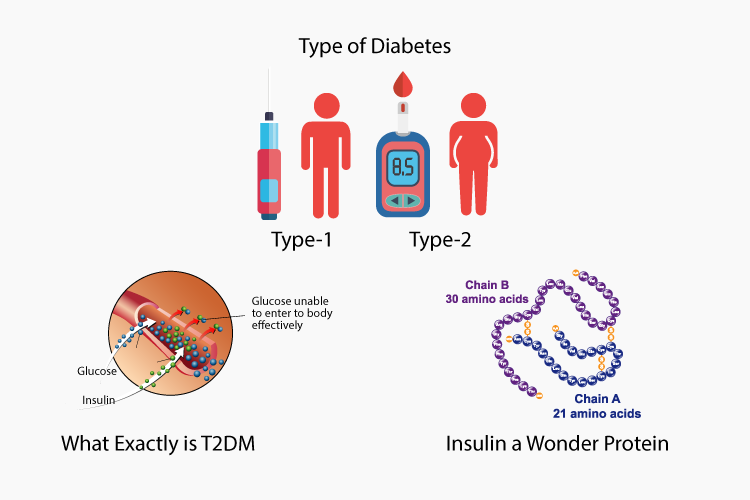 Diabetes is a group of metabolic diseases characterized by hyperglycemia (raised levels of blood glucose or blood sugar), resulting from defects in insulin secretion, insulin action or both. People with diabetes are at an increased risk of developing a number of health-related side effects. Chronic hyperglycemia is usually associated with long-term damage, dysfunction and organ failure, especially of kidneys, eyes, nerves, heart and blood vessels. Having diabetes puts an individual at a 50 percent higher risk of death in adulthood.
Diabetes is a group of metabolic diseases characterized by hyperglycemia (raised levels of blood glucose or blood sugar), resulting from defects in insulin secretion, insulin action or both. People with diabetes are at an increased risk of developing a number of health-related side effects. Chronic hyperglycemia is usually associated with long-term damage, dysfunction and organ failure, especially of kidneys, eyes, nerves, heart and blood vessels. Having diabetes puts an individual at a 50 percent higher risk of death in adulthood.
Types of Diabetes
There are three main types of Diabetes Mellitus (DM). These are type I, type II-DM and gestational DM.
Type I Diabetes Mellitus (T1DM)
It is a chronic autoimmune disease characterized by the immune-mediated destruction of the β-cells of the pancreas by T cells which customarily provokes complete insulin insufficiency. The genetic basis of T1DM is complex. It was formerly known as insulin-dependent, juvenile or childhood-onset diabetes. Type I diabetes is distinguished by deficient insulin production in the body. In such a type of DM, patients require daily administration of insulin so as to normalize the glucose levels in the blood.
Type II Diabetes Mellitus(T2DM)
It is usually termed as non-insulin-dependent or adult-onset diabetes. Type II diabetes is the most typical DM where the body is capable of producing insulin but becomes so resistant that the insulin is ineffective. The cause of high blood glucose levels is both insulin resistance and deficiency.
Gestational diabetes mellitus (GDM)
This type of DM is determined in the second or third trimester of pregnancy, which is not clearly overt diabetes (most advanced stage). GDM is a provisional disorder that happens in pregnancy. Women with slightly elevated blood glucose levels are diagnosed as having gestational diabetes, whilst women with substantially elevated blood glucose levels are classified as having diabetes mellitus in pregnancy.
GDM usually tends to arise from the 24th week of pregnancy. Screening by means of an oral glucose tolerance test is therefore recommended and must be conducted early in pregnancy for high-risk women, and between the 24th and 28th week of pregnancy in all other women.
Epidemiology of T2DM
It can be categorized as one of the world’s major diseases considering that it affects a high proportion of the population on earth.
Global: The global prevalence of diabetes in adults (20-79 years old) according to a report published in 2013 by the IDF was 8.3% (382 million people), with 14 million more men than women (198 million men vs 184 million women), the majority between the ages of 40 and 59 years. The number is expected to rise beyond 592 million by 2035 with a 10.1% global prevalence. The 2017 National Diabetes Statistics Report estimated that 12.2 % of U.S. adults 18 years old and above had diabetes in 2015.
National: According to the findings of the Indian Council of Medical Research study published in 2011, India is faced with a galloping diabetes epidemic that is progressing at a speed that challenges the meanest and fastest. By the year 2030 patients with diabetes are estimated to reach beyond 100 million.
Insulin a Wonder Protein
Insulin was first isolated in 1921 by Banting and Best and used in the treatment of diabetes mellitus in 1922. It was completely synthesized in 1996. Insulin is a protein chain or peptide hormone. There are 51 amino acids in an insulin molecule. It has a molecular weight of 5808 Da. The most important factor controlling insulin secretion is glucose. An increase in blood glucose level promotes both the synthesis and secretion of insulin from the beta-cells.
It causes the cells in the muscles, liver, and fat tissue to take up glucose from the blood and convert it to glycogen that can be stored in the liver and muscles. Insulin also prevents the utilization of fat as an energy source. In the absence of insulin or in conditions where insulin is low, glucose is not taken up by body cells, and the body begins to use fat as an energy source. Insulin also controls other body systems and regulates the amino acid uptake by body cells.
What Exactly is T2DM?
Diabetes is a condition where there is an increase in blood sugar levels. Most of the food we eat is turned into glucose or sugar molecules by our bodies to use it in the form of energy. The pancreas, an organ that lies near the stomach, makes a hormone called insulin to help glucose get into the cells of our bodies.
When you have diabetes, your body either doesn’t make enough insulin or can’t use its own insulin as well as it should. This causes sugar to build up in your blood. This is why many people refer to diabetes as “sugar.”
Insulin resistance and impaired insulin secretion remain the core defects in T2DM, but at least six other pathophysiological abnormalities contribute to the dysregulation of glucose metabolism.
Different Causative Factors for T2DM
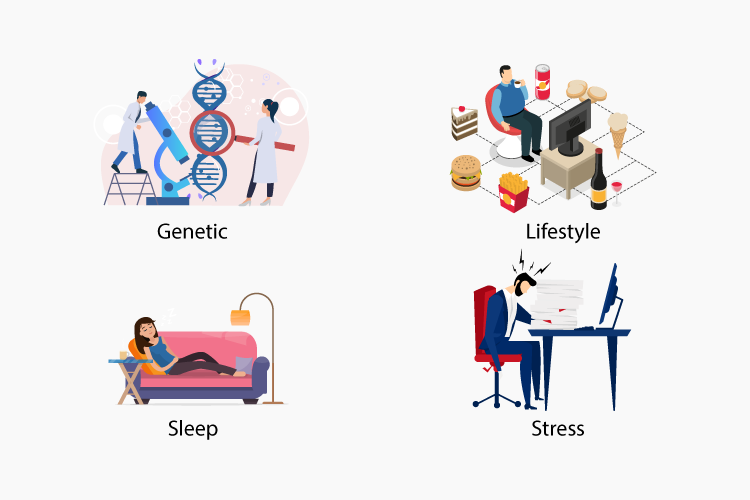 Genetics
Genetics
The heritability of T2DM is high (estimated to be > 50%) and provides evidence of the genetic risk associated with T2DM. However, only 10% of the heritability can be attributed to the genetic loci discovered so far, because most of these loci display a very low effect size.
Lifestyle
Globally, type 2 diabetes mellitus (T2DM) is considered as one of the most common diseases. The major precipitating factor is the environment and high-calorie food intake with a sedentary lifestyle. they have been indisputably linked to the development of obesity and T2DM. The lack of physical activity due to increased preference to access motorized transport, escalators and elevators; professions which entail little physical activity and a sedentary posturing may increase T2DM risk.
Dietary Factors
Dietary culprits chiefly include processed, energy-dense foods characterized by high sugar and fat. Micronutrient imbalances that include intake of a diet low in Vitamin D, Vitamin B12 and increased body iron stores have also been implicated in the pathogenesis of T2DM. If you have been gaining weight, eating a lot of high-fat and high-sugar foods, and/or not getting much exercise; there are high chances of getting diabetes.
Relation of Sleep and Diabetes
When you do not get enough sleep, your body becomes less sensitive to insulin. In one study of sleep-deprived young males, insulin levels in the blood were up to 50% higher when they did not get enough sleep. It may not always be this striking, but not getting enough sleep appears to be directly linked to high levels of insulin in the bloodstream.
Over time, these high levels of insulin can cause your body to become more and more insulin resistant, and possibly lead to diabetes. The insulin resistance that comes with not enough sleep can intensify your preexisting diabetes, making it much harder to control your blood glucose levels and putting you at a higher risk of developing complications.
Stress
Our lives are full of things that can cause stress. When you feel stressed, your body gets ready for action. It pumps stress hormones into your blood. Stress hormones make your body release stored glucose and stored fat for extra energy. This extra energy helps your body to face up to or run away from the stress. But the extra glucose and fat can only be used by your body if there is enough insulin.
Family History
It has been observed in various studies that first-degree relatives (a person’s parent, sibling, or child) of people with type 2 diabetes are themselves at risk of developing the disease. While the transmission of genetic information from parents to offspring contributes to diabetes risk; there are other nongenetic risk factors such as dietary habits, sedentary lifestyles, and stress that may lead to T2DM.
Major Signs and Symptoms of T2DM
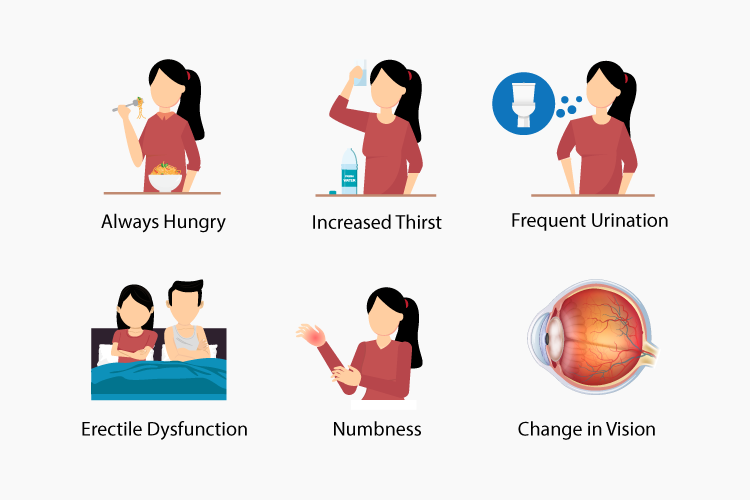 The 3 P’s
The 3 P’s
The classic symptoms of diabetes such as polyuria (frequent urination), polydipsia (increased thirst) and polyphagia (extreme hunger) occur commonly in type 1 diabetes, which has a rapid development of severe hyperglycemia and also in type 2 diabetes with very high levels of hyperglycemia.
Erectile Dysfunction
About half of the men with diabetes have erectile dysfunction (ED). Keeping your blood glucose levels under control is the best way to avoid erectile problems. If you do experience some difficulty during sexual activity, talk with your doctor. There are many treatment options available.
Pre-Diabetes (Bottom Line Diabetes)
Prediabetes affects most of the population in the age group of forty to seventy-four—well into your older years. In these individuals, blood glucose levels are elevated but not enough to be considered as type 2 diabetes. There’s a good chance that a person diagnosed with prediabetes will develop type 2 diabetes within ten years.
Change in Vision
Blurry vision is the first warning sign for T2DM. Anyone who develops blurry vision may have possibilities of having diabetes. They need to see a doctor especially if a problem appears suddenly or gets worse. High blood sugar could result in swelling of your lens resulting in disability to vision. People with diabetes are more likely to get an eye disease than people without diabetes.
Numbness or Tingling in feet and Hands
Numbness and tingling in hands and feet may be a sign of diabetes. Usually, damage to sensory nerves, nerves responsible for carrying signals that alert us to sensations, including pain, heat, and cold is a sign of diabetes.
Who Should Go for Screening and Testing of T2DM
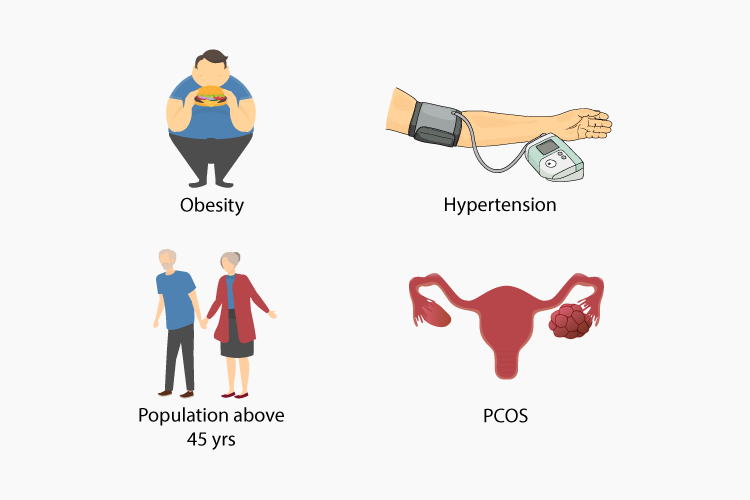 Obese Individual
Obese Individual
The link between obesity and type 2 diabetes has long been established. While many of the complications associated with diabetes are linked to the metabolic consequences of increased
adipose tissue mass, it is important to remember that other sequelae in the guise of obesity-related co-morbidities are common in diabetic patients. It is known that the prevalence of insulin resistance is greater among obese.
Hypertensive
Hypertension is a feature of Type 2 diabetes and is thought to result from a failure of insulin-induced vasodilation to counteract both renal sodium reabsorption and activation of the sympathetic nervous system.
Low HDL Cholesterol
Those with high BMI ( Body Mass Index) are needed to constantly monitor their cholesterol levels. It has been observed that low levels of HDL cholesterol are consistently associated with an increased risk of type 2 diabetes. As visceral adipose tissue increases plasma triglyceride (TG) concentrations are elevated, high-density lipoprotein (HDL) cholesterol decreases and low-density lipoprotein (LDL) cholesterol increases.
PolyCystic Ovary Syndrome ( PCOS)
PCOS is so prevalent nowadays, affecting 4-18% of women of reproductive age. Individuals with PCOS are more prone to be obese. Polycystic ovary syndrome (PCOS) is identified as a significant non modifiable risk factor associated with Type 2 diabetes mellitus (T2DM) by the International Diabetes Federation.
These include increased risk factors for impaired glucose tolerance, type 2 diabetes mellitus (T2DM) and cardiovascular disease. Insulin resistance is proposed as a key pathophysiological feature of PCOS contributing to both the reproductive and metabolic disturbances as well as contributing to an increased cardiometabolic risk for women with PCOS.
Population above 45 years
Middle-aged and older adults are still at the highest risk for developing type 2 diabetes. Adults aged 45 to 64 were the most diagnosed age group for diabetes. So nowadays it’s mandatory to go for an oral glucose tolerance test (OGTT) at a certain age. As a person ages, the capacity of their kidneys to absorb excess glucose increases.
Diabetes Complications
 Neuropathy (Stroke)
Neuropathy (Stroke)
Nerve damage is called neuropathy. Neuropathy affects the nerves outside the brain and spinal cord.
These are called peripheral nerves. A stroke occurs when blood flow to the brain is blocked. This type of stroke is called an ischemic stroke.
If blood flow to the brain is blocked for only a brief time, it is called a transient ischemic attack (TIA). Having diabetes doubles your chances of having a stroke. If you have other risk factors for stroke, your chances of having a stroke are even greater.
Nephropathy (Kidney Diseases)
Kidneys clean your blood. Your blood flows through filters in your kidneys. The filters let wastes pass out to your urine while keeping good and useful things in your blood in healthy functioning kidneys. But diabetes may result in unhealthy kidneys. Unhealthy kidneys can get kidney disease.
People with diabetes often have high levels of glucose in their blood. High levels of glucose make your kidneys filter blood more often than is really needed. In kidney disease, kidneys go from being overworked to leaky and may lead to kidney failure.
Retinopathy (Eye Disease)
The retina is the lining at the back of the eye that senses light. Small blood vessels bring oxygen to the retina. Retinopathy damages the small blood vessels in the retina. The two major types of retinopathy are nonproliferative and proliferative. People with diabetes are more likely to get an eye disease than people without diabetes. Retinopathy is the most common eye disease and carries the highest risk of reducing your vision.
Wound Healing
Wound healing is delayed, especially in type II diabetic patients. Poor circulation and cellular response to tissue injury can slow the healing of wounds and infections especially in diabetes patients. That may result in dry gangrene. Be alert to the signs of blood vessel damage to the legs and feet. If infection sets in, you may have wet gangrene. The only treatment for wet gangrene is amputation. Amputation is the removal of dead tissues. It might mean you lose a toe, several toes, a foot, or part of a foot.
Test Recommended for T2DM
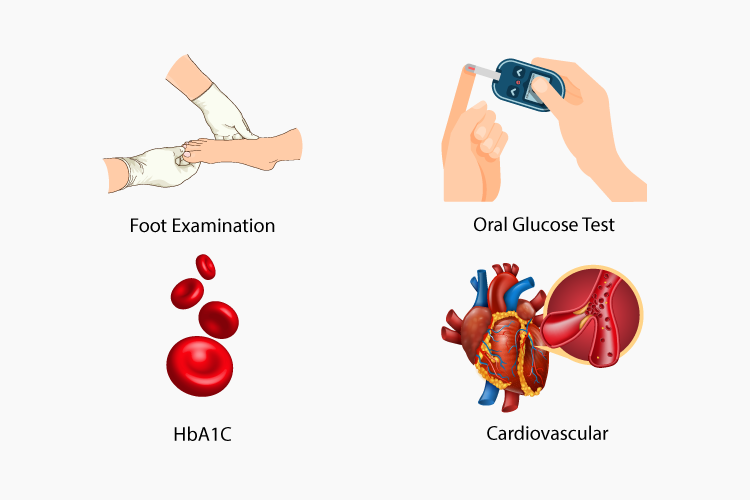 HbA1c
HbA1c
One of the most common methods of identifying people at risk in the western world is with a blood test that analyses the amount of glycated HbA1c in a person’s blood. The glycated HbA1c test essentially gives you an average of your blood sugar levels over the last 3 months. High HbA1c readings indicate high levels of blood sugar over a sustained period of time, a hallmark of T2DM.
Cardiovascular markers
People with diabetes are more susceptible to heart disease. That’s because elevated glucose levels accelerate the buildup of plaque in the arteries. For this reason, various blood tests are recommended such as homocysteine, C-reactive protein, fibrinogen, lipoprotein A, apolipoprotein A and B, and iron.
Oral Glucose Tolerance Test
The Oral Glucose Tolerance Test (OGTT) is a test used for the diagnosis of diabetes. The individual is required to fast overnight for 8 to 10 hours (water can be consumed) and the test is done on the following day in the morning. The fasting blood sample is taken and then the person is given a glucose load which is 75gm of glucose in 250-300ml of water. The glucose load should be consumed over a period of 5 minutes. After 2 hours, the blood sample is collected again, the values are estimated and the condition is predicted by a physician.
Foot examination
People with diabetes can get many kinds of foot problems. Even minor ones can turn into serious ones. If blood glucose levels are high, you are more likely to get foot problems. A careful inspection of the feet should always be carried out by the patient frequently, as diabetic individuals are more prone to the development of foot ulceration.
Self Check of Blood Glucose?
Blood glucose self-check tells you how much glucose is in your blood at any one time. Anyone with diabetes can benefit from self-checks. You check your blood glucose with a glucometer. By home testing following the general steps as per guidelines, one can have proper control over diabetes.
Interventions for Preventing T2DM
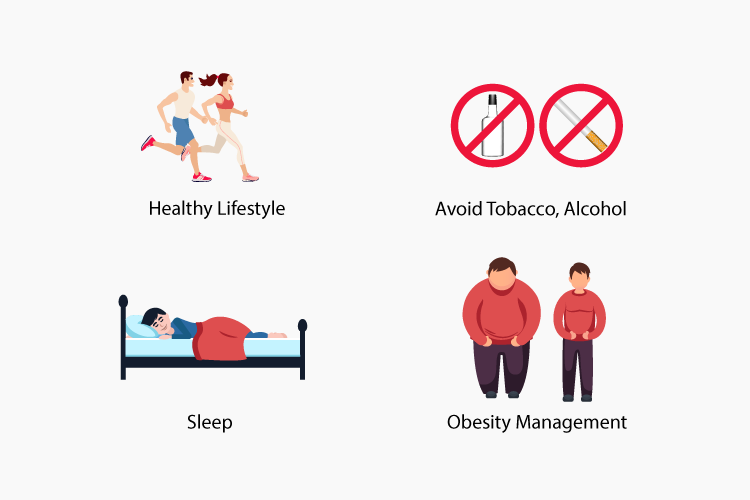 Avoid Tobacco and Limit Consumption of Alcohol
Avoid Tobacco and Limit Consumption of Alcohol
Quitting smoking is good for your diabetes. When you quit smoking, you lower your blood pressure and raise your HDL cholesterol (healthy cholesterol) ) and your oxygen intake. Quit smoking and you can reduce your risk for heart disease, blood vessel damage, kidney disease, nerve damage, dental disease, and cancer (mouth, throat, lungs, and bladder). Individuals should always limit alcohol consumption and should be moderate as alcohol may cause blood glucose levels to rise and fall. Excessive alcohol consumption may lead to weight gain and insulin resistance.
Adopt a healthy lifestyle
One needs to promote and support healthy eating patterns, emphasizing a variety of nutrient-dense foods in appropriate portion sizes in order to improve overall health which would help to attain an individualized glycemic index. Maintaining appropriate body weight will help to maintain the ideal lipid profile. While dietary changes are certainly effective, participating in regular aerobic physical activity is important. Positive changes in lifestyle behavior as a whole may be a feasible and effective approach.
Obesity Management
Obesity and type 2 diabetes are interrelated. There is strong and consistent evidence that obesity management can delay progression from prediabetes to type 2 diabetes. In obese patients with type 2 diabetes, modest and sustained weight loss has been shown to improve glycemic control. Diet, physical activity, and self-monitoring could help to achieve weight loss and maintain ideal weight. Proper measures should be taken to maintain a healthy weight.
Adequate Sleep
Having adequate sleep is one of the important factors for T2DM. People who are sleeping less or having sleep disorders are on the rise. Sleeping less than 7 hours per night may increase the risk of T2DM. The importance of sleep for metabolic function and specifically glucose homeostasis is now widely accepted. Many studies have shown a correlation between sleep deprivation or poor sleep quality and an increased risk of diabetes.
Various ways to manage T2DM
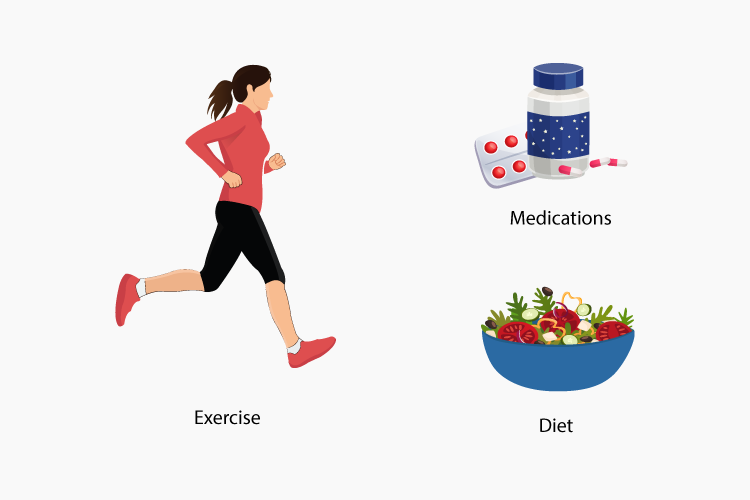 Physical Exercise
Physical Exercise
Maintaining a healthy body weight or working to reduce your weight if you are overweight, can help to reduce your cholesterol levels, your blood pressure, as well as your blood sugar.
Even a daily walk around may help. Find exercises and activities you enjoy. If tolerated, exercising 30 minutes at least 5 days weekly should be a goal. Exercise has the potential to lower your blood sugars.
Oral diabetes medications
It consists of diabetes pills that help people with type 2 diabetes to control blood glucose levels. Physicians may prescribe diabetes pills for people who are not able to keep their blood glucose at safe levels with healthy eating and exercise.
There are different drug classes for diabetes control: sulfonylureas, biguanides, alpha-glucosidase inhibitors, thiazolidinediones, meglitinides, DPP-4 inhibitors, and SGLT2 inhibitors. These medications are prescribed strictly under physician supervision.
Dietary Therapy and Attitude Towards Food
Diets that are considered “healthier” lead to better long-term weight maintenance. Maintaining a healthy weight by opting for a healthier diet and nutritional habits is the best option to overcome diabetes. Getting nutrients such as proteins, carbohydrates, fats, vitamins, and minerals from what you eat and drink is considered as the best nutrition. These dietary factors may affect your blood glucose level and your weight. How many calories you need to eat in a day to stay at or achieve a healthy weight is very important for diabetes control. Hence, diet therapy helps in T2DM.
The Fit Indian Support
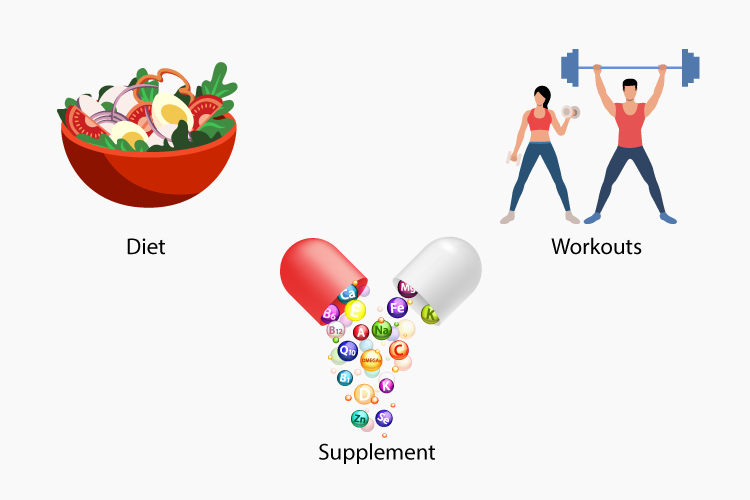 Diabetes-Friendly Diet Plans
Diabetes-Friendly Diet Plans
The diabetes diet plans were planned by our expert nutritionists considering the calorie and the macronutrient requirements for the day.
Fiber-rich foods
Fiber content in the food delays the process of digestion and releases the glucose into the blood slowly, thereby preventing the sharp rise of glucose level in the blood after the consumption of food. Fibre also delays the hunger by providing longer satiety.
Foods with a low glycemic index
Glycemic index of the food plays a vital role in maintaining blood sugar level.High glycemic food raises the blood sugar level rapidly after consumption whereas medium to low glycemic index foods raises the blood sugar slowly and steadily. The foods included in the diet are in the range of medium to low glycemic index.
Complex carbohydrate diet
Foods high in complex carbohydrates are included as part of the diet which is helpful to control and stabilise the blood sugar level throughout the day.
Proper hydration
It is important for a diabetic patient to maintain proper hydration as there is an increased risk of dehydration. Drinking a sufficient amount of fluid may help to eliminate the excess blood sugar from the body and also helps to prevent other complications which may arise due to diabetes.
Moderate protein
Protein on digestion does not release glucose molecules, rather it produces amino acids which do not have an impact on the glucose levels in the blood. Adequate protein in the diet helps to provide energy without affecting the blood glucose levels. Due to the hyperglycemic state muscle wasting occurs which leads to weight loss. Therefore, in order to prevent this, it is important for diabetic individuals to maintain their protein intake.
Weekly Menu Plan
| Week 1 | Week 2 | Week 3 | Week 4 | |
|---|---|---|---|---|
| Early Morning (6:00 AM – 7:00 AM) |
Have 1 glass of Warm Water with 1/2 tsp of Sprouted Methi Seeds as soon as you wake up. | Have 2 glasses of Warm Water with 1/4 tsp of Cinnamon Powder [AND] Have 10-12 Almonds (soaked overnight and peeled before eating) as soon as you wake up. |
Have 1 glass of Water diluted with 1 tbsp of Aloe Vera Juice [AND] Have 2 whole Walnuts as soon as you wake up. |
Have 1/2 litre of Water (stored overnight in copper bottle) as soon as you wake up [AND] After 30 minutes, have 1 cup of Tea with 2 Digestive Biscuits. |
| Approximate Calories | 4 kcal | 100 kcal | 62 kcal | 100 kcal |
| Breakfast (8:00 AM – 10:00 AM) |
Have 2 Moong Dal Chilla topped with grated Paneer with Sesame Seeds Chutney. | Have 1 Whole Egg Vegetable Oats Omelette. | Have 2 Spinach Carrot Idlis with 1 cup of Sambar. | Have 1 bowl of Papaya Yogurt Smoothie with 2 tsp of Flax Seeds. |
| Approximate Calories | 330 kcal | 140 kcal | 320 kcal | 250 kcal |
| Midmorning (11:00 AM – 12:090 PM) |
Have 1 mug of Green Tea [AND] After 30 minutes, have 1 cup of cut Guava. |
Have 1 glass of Buttermilk with 1 tsp of Flax Seeds [AND] After 30 minutes, have 1 cup of Blueberries. |
Have 1 bowl of cut Fruits [AND] After 30 minutes, have 2 Boiled Egg Whites |
Have 1 mug of Green Tea [AND] After 30 minutes, have 8 Almonds and 1 Walnut. |
| Approximate Calories | 130 kcal | 230 kcal | 130 kcal | 90 kcal |
| Lunch (12:30 PM to 2:00 PM) |
Have 1 Cup of Broccoli Chicken Salad and 1/2 cup of cooked Rice with 1 cup of Vegetable Soy Chunks curry. | Have 1 cup of Raw Vegetable Salad and 2 Millet Phulkas with 1 cup of Thick Dal. | Have 1 cup of boiled Beetroot and 1/2 cup of cooked Rice with 1 cup of Dal gourd [AND] After 10 minutes, have 1 glass of Buttermilk. |
Have 1 cup of Vegetable Pulao with 1 cup of Chicken Capsicum Curry and 1/2 cup of Plain Curd. |
| Approximate Calories | 340 kcal | 360 kcal | 220 kcal | 320 kcal |
| Snack (4:00 PM to 5:00 PM) |
Have 1 cup of Tea / Coffee [AND] After 30 minutes, have 1/2 cup of Boiled Cowpeas. |
Have 200 ml of Soy Milk [OR] Have a handful of Dry Nuts. |
Have 1 cup of Tea with 2 Bajra Khakras (small). | Have 1 cup of Bhel Chat [AND] After 30 minutes, have 1 Orange. |
| Approximate Calories | 160 kcal | 310 kcal | 80 kcal | 240 kcal |
| Dinner (7:00 PM to 8:30 PM) |
Have 1 cup of Dalia Khichdi with 1 cup of Bottlegourd Curry. | Have 1 bowl of Ragi Sev Upma cooked with Vegetables and 1 cup of Plain Curd. | Have 2 Methi Parathas with 1 cup of Rajma Curry. | Have 1 Chapathi wrapped with Stir Fried Veggies and shredded Chicken [AND] Have 1 cup of Boiled Vegetables. |
| Approximate Calories | 300 kcal | 260 kcal | 300 kcal | 250 kcal |
| Bedtime (9:00 PM to 10:00 PM) |
Have 1 cup of warm Skim Milk before going to bed. | Have 1 glass of Water and 2 Dates before going to bed. | Have 1 glass of Soy Milk before going to bed. | Have 1 glass of warm Skim Milk before going to bed. |
| Approximate Calories | 120 kcal | 34 kcal | 108 kcal | 120 kcal |
| Total Calories | 1400 kcal | 1400 kcal | 1400 kcal | 1400 kcal |
Workouts
We offer an exercise program with a meal plan that suits your health conditions. Participate in physical activity that is appropriate to age, makes you happy, and has a variety of workouts.
Aerobic: Regular walking or jogging 5 days a week for 30-40minutes is advised. Swimming is also a good option for being a hobby and a full-body activity.
Strength Training: This type of exercise builds muscle, which burns more calories than fat even when you are not exercising. Aim for two to three sessions of strength training weekly, on alternate days.
Supplement Therapy for T2DM
Biotin
It is also known as vitamin B7 and vitamin H, and is a member of the B vitamin
family. It assists with the metabolism of fats, carbohydrates, and proteins. Biotin supplementation is recommended for people with diabetes as it may lower blood glucose levels .
Calcium
Calcium is best known for its critical role in the formulation of bones and teeth. More than 99 percent of the calcium in the body is stored in the bones, the remaining 1 percent plays an essential role in other body functions. In some studies it has been found thet daily supplementation of calcium and vitamin D may help improve insulin sensitivity.
Chromium
Chromium is an essential trace mineral. It helps the body to maintain healthy levels of cholesterol and blood sugar. It has been observed that deficiency of chromium may hamper glucose utilization.Chromium works together with insulin to drive sugar from the blood to tissues.
Green tea
Green tea is a rich source of polyphenols, a powerful antioxidant. Epigallocatechin gallate (EGCG) is the main antioxidant found in green tea. May help in T2DM.
Jamun
It is a miracle dietary supplement for diabetes. Both seeds and the fruit are used in diabetes care. It slows down the release of sugar into the blood.
Noni
Noni is also known as morinda .Consumption of noni fruit juice may help to regulate elevated blood sugar levels. It is available in various forms like noni juice, noni drops, noni tablets and capsules.
Wheatgrass
Wheatgrass has been a boon for people with diabetes. It has shown to improve blood sugar levels. It may lower the glycemic index of foods, which has a positive effect on blood sugar levels. Dietary supplement available as juice, drops, capsules and tablets.
Conclusions
Type 2 diabetes mellitus is a disease characterized by hyperglycemia resulting from defects in insulin secretion.Your body either doesn’t make enough insulin or can’t use its own insulin as required. According to the World Health Organization (WHO) projections the prevalence of diabetes is likely to increase by 35% by the year 2025 .The incidence of diabetes is on the rise due to various factors like diet, nutrition, stress, sedentary lifestyle and many more. T2DM could be managed through various ways like physical exercise, dietary approach, and medication. TFI brings you healthy practices into an already busy schedule in economically challenged lifestyles is a preferable approach to control T2DM.

Compiled by
Dr Vrushali Pulate (PhD in Bio process Technology)
Technical Content Director and Product Head
Pyrite Fitness Pvt. Ltd.
Her research interests are biosurfactants, pharma biotech, food sciences, analytical chemistry with five international publications in peer-reviewed journals. Awarded research fellowship DBT- India (2007-2009) and UGC-SAP- Delhi India (2009-2014).
Frequently Asked Questions
This is not true. It has been observed that being overweight or obese raises the risk of becoming diabetic. It does not mean that an obese person will definitely become diabetic. Many people with type 2 diabetes were never overweight.
Each and every individual needs to take diabetes seriously. It has been observed that two-thirds of diabetes patients die prematurely from stroke or heart disease. The life expectancy of a person with diabetes is from five to ten years shorter than other people’s.
This is not always true. A diet high in calories, which can make people overweight/obese, raises the risk of developing type 2 diabetes, especially if there is a history of this disease in the family.
High blood sugar levels are never normal for anybody. Some illnesses, mental stress, and steroids can cause temporary hikes in blood sugar levels in people without diabetes. Anybody with higher-than-normal blood sugar levels or sugar in their urine should be checked for diabetes by a healthcare professional.
It’s not completely true, people with diabetes can eat starchy foods. You must keep an eye on the size of the portions. Whole grain starchy foods are better.
Not true. Diabetes is not communicable. Diabetes is a condition that usually develops due to sedentary lifestyles, dietary habits. Parents may pass it on through their genes to their offspring.
As childhood obesity rates, poor diet, and physical inactivity is on the rise nowadays; a growing number of children and teenagers are developing type 2 diabetes.
Actually, it does not usually have anything to do with the severity of the disease. Individuals are on insulin when diet alone or diet with oral or non-insulin injectable diabetes drugs do not provide good-enough diabetes control.
It is not true, people with diabetes can eat chocolates and sweets if they combine them with exercise or eat them as part of a healthy meal.
It is not always true. Causative factors like obesity, sedentary lifestyle play a major role in the development of diabetes. In some studies, it has been found that diabetes risk appears to be inherited.
- Diabetes mellitus: The epidemic of the century; World J Diabetes; Vol-6: 2015.
- Nutritional Management of Diabetes Mellitus; John Wiley & Sons Ltd, England; 2003.
- Diabetes Mellitus: A Review on Pathophysiology, Current Status of Oral Medications and Future Perspectives; Acta Pharm. Sci. Vol 55: 2017
- The Complete Guide To Vitamins Herbs And Supplements; A Lynn Sonberg Book; Harpercollins Ebooks; 2005.
- Diabetes Unpacked: Just Science and Sense, No Sugar Coating; Columbus Publishing Ltd 2017.
- Diabetes: Causes, Symptoms, And Treatments; Public Health Environment and Social Issues in India;2016